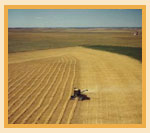Agriculture Today
 The past century has seen the growth of a dynamic agricultural industry in Alberta. In that time,
the industry has undergone significant changes. The number of farms has
decreased, but the average farm size has increased by more than two-fold. (This
long-term trend recently reversed for the first time since 1931 because of the
increasing number of small
specialty farms.) The area of the agricultural land base has also changed,
increasing by 33 percent from 15.8 million hectares to 21.0 million hectares. This land base represents about
one third of the area of the province. The past century has seen the growth of a dynamic agricultural industry in Alberta. In that time,
the industry has undergone significant changes. The number of farms has
decreased, but the average farm size has increased by more than two-fold. (This
long-term trend recently reversed for the first time since 1931 because of the
increasing number of small
specialty farms.) The area of the agricultural land base has also changed,
increasing by 33 percent from 15.8 million hectares to 21.0 million hectares. This land base represents about
one third of the area of the province.
Technological
advances have been a major factor influencing these trends. Mechanized farming
and modern methods, such as the use of chemical fertilizers and pesticides, have
enabled fewer people to do more work and produce more than was previously
possible. Economic factors have favoured large-scale operations. Of the total
farmland in 1996, approximately 52 percent was cultivated, and 41 percent was
pasture. The remainder had various uses (farmyards, wetlands, woodlots, etc).
Primary
agriculture is Alberta's largest renewable
resource-based industry. Alberta
accounts for 25 percent of annual Canadian agricultural production with only
nine percent of Canada's population. In 1996, primary agriculture generated a
record $6.4 billion in farm cash receipts, representing 22.6 percent of Canada's
primary agricultural output. Typically, annual sales of products are about
evenly balanced between crops and livestock. Agricultural processing, including
food and beverage processing industries, is Alberta's largest manufacturing
sector.
Combined, the
agricultural production and processing sectors were the second largest employer
in the province in 1996. Employment in the agricultural and agri-food industries
averaged 116,200 jobs during 1996. Alberta's agri-food industry contributes roughly five
percent of the provincial gross domestic product.
Department of the Environment. State of the Environment Report, Terrestrial Ecosystems.
Edmonton: n.p., 2001. With permission from Alberta Environment.
 
|
|
 Heritage Community Foundation Presents
Heritage Community Foundation Presents





